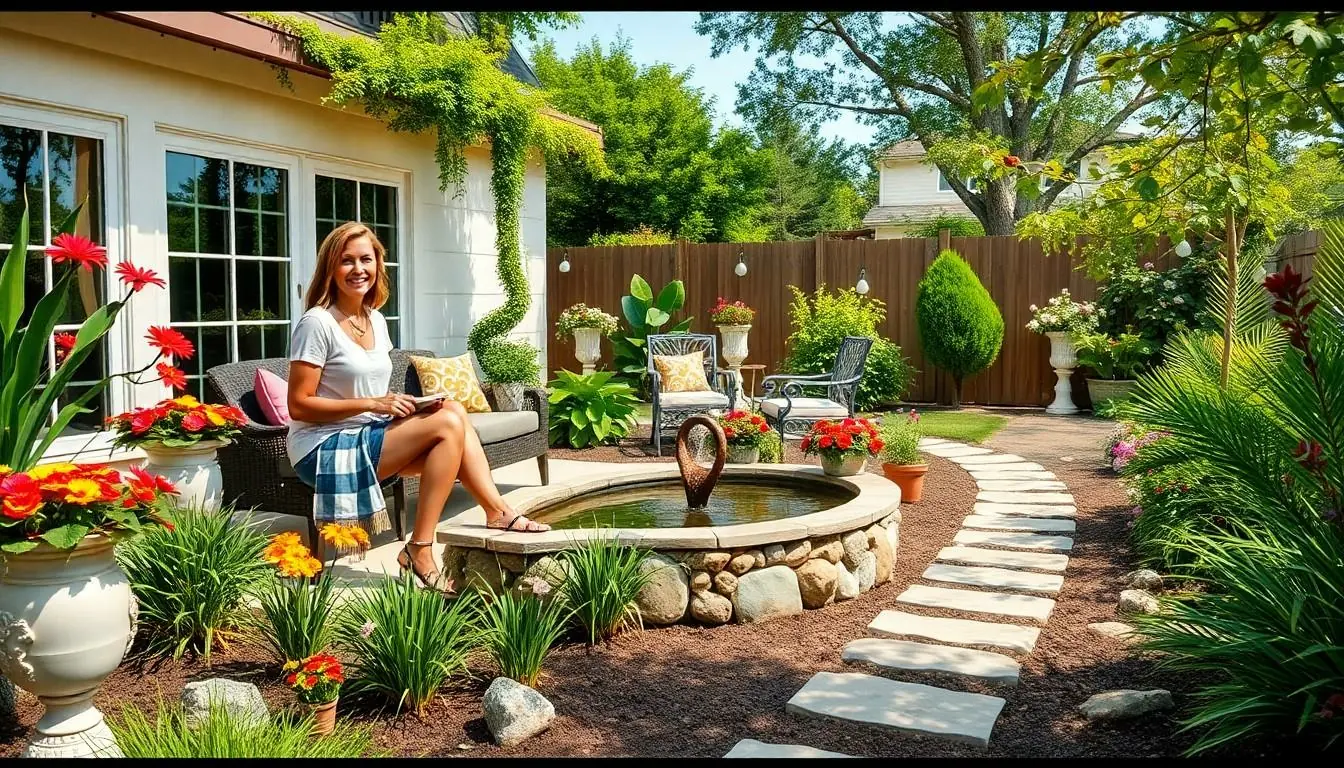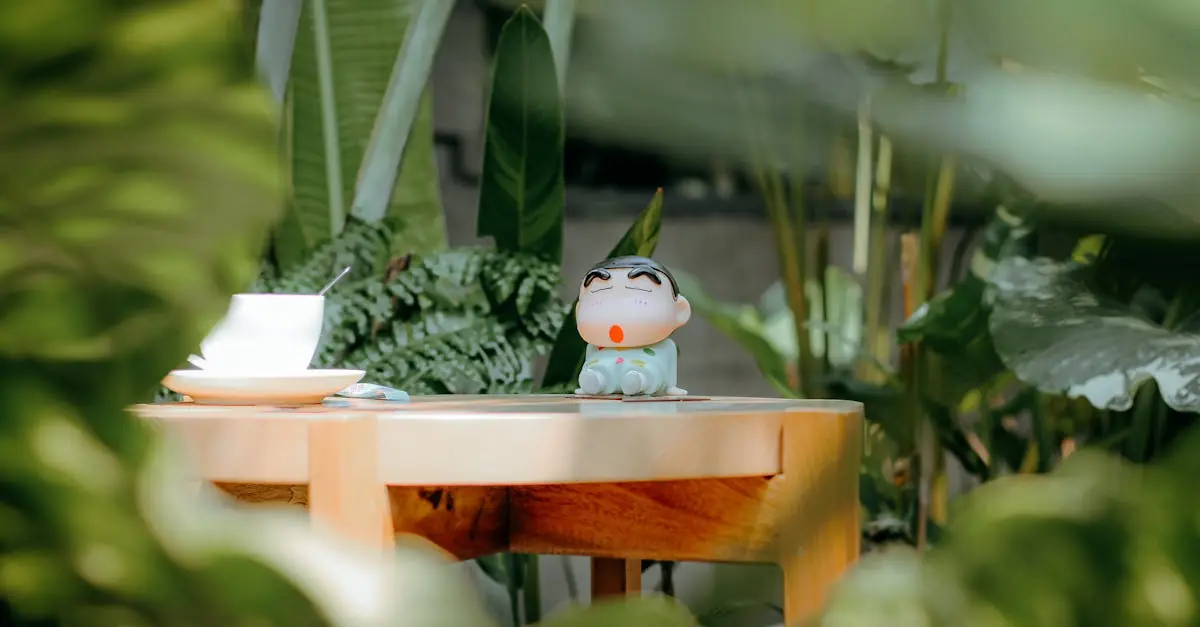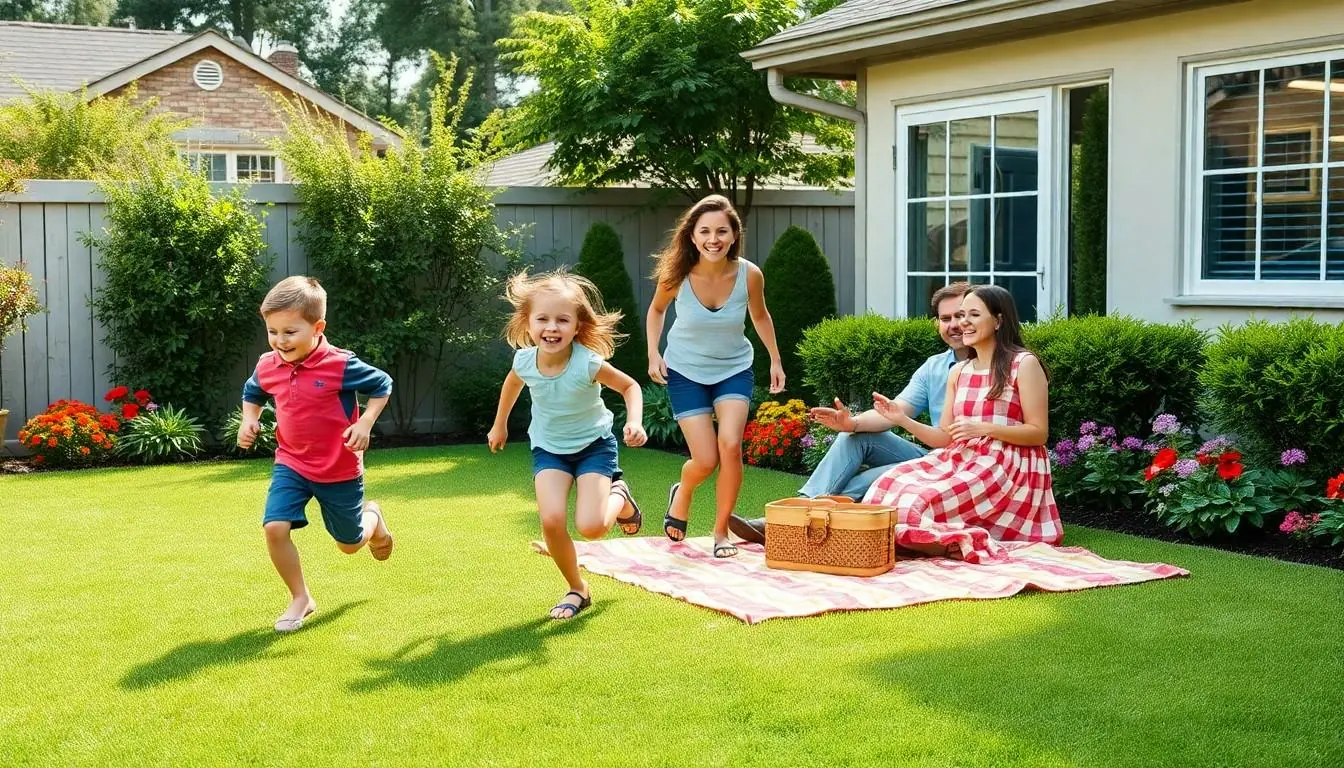Transforming a backyard into a stunning oasis doesn’t have to feel like an episode of a DIY reality show gone wrong. With the right landscaping designs, anyone can turn their outdoor space into a personal paradise. Whether it’s a cozy nook for sipping coffee or a vibrant garden that rivals the local botanical garden, the possibilities are endless.
Table of Contents
ToggleOverview of Backyard Landscaping Designs
Backyard landscaping designs offer creative solutions to enhance outdoor spaces. Various styles exist to cater to individual preferences, including contemporary, rustic, and tropical themes. Each design emphasizes functionality and aesthetic appeal, allowing homeowners to create inviting environments.
Layout plays a critical role in landscaping. Design elements such as paths, patios, and garden beds contribute to overall coherence. Incorporating native plants minimizes maintenance and promotes local biodiversity, benefiting the environment. Additionally, water features like ponds and fountains add tranquility and draw attention.
Functionality should guide the selection of materials and plant species. Durable materials, such as stone and wood, withstand varying weather conditions, ensuring longevity. Choosing the right plants enables year-round visual interest, with evergreens and flowering species providing dynamic seasonal changes.
Sustainable practices enrich backyard landscaping designs. Composting organic waste promotes soil health and decreases dependence on chemical fertilizers. Rain gardens capture and filter runoff, contributing to responsible water management.
Outdoor living spaces enhance enjoyment and usability. Patios, decks, and outdoor kitchens create gathering spots, making it easier for families and friends to connect. Shade structures, like pergolas and umbrellas, offer relief from the sun, extending usability throughout the day.
Incorporating personal touches is vital for creating a unique oasis. Art installations, decorative lighting, and custom planters infuse character and reflect individual tastes. Thoughtful design choices elevate the outdoor experience, transforming backyards into personal retreats.
Types of Backyard Landscaping Designs

Backyard landscaping designs offer various styles to fit different tastes and needs. Each design brings a unique character to outdoor spaces.
Formal Landscaping
Formal landscaping features symmetrical designs and structured layouts. Often, it includes geometric shapes in hedges, flower beds, and pathways. These areas emphasize balance and order, drawing attention to central elements like fountains or statues. Additionally, boxwood shrubs and rose bushes create defined borders, enhancing visual appeal. This style suits traditional homes and provides a timeless backdrop for events.
Informal Landscaping
Informal landscaping showcases natural beauty with curved lines and unstructured planting. It integrates native plants and ornamental grasses, which promote biodiversity. Garden beds appear spontaneous, allowing for a relaxed atmosphere. Stone pathways meander through lush greenery, inviting exploration and interaction. This design encourages wildlife and supports a vibrant ecosystem, appealing to homeowners who favor a more casual, rustic feel.
Xeriscaping
Xeriscaping focuses on water conservation while maintaining visual interest. It incorporates drought-resistant plants adapted to local climates. Gravel, mulch, and rock gardens replace traditional grass lawns, reducing irrigation needs. This approach not only conserves resources but also enhances sustainability. By choosing native species, xeriscaping promotes habitat restoration, ultimately benefiting the environment and lowering maintenance costs.
Key Elements of Effective Backyard Landscaping
Effective backyard landscaping combines various elements to create a harmonious outdoor environment. Understanding these key components enhances both aesthetics and functionality.
Plant Selection
Choosing the right plants is crucial for a successful landscape. Native plants thrive in the local climate, requiring less maintenance and promoting biodiversity. Selection involves considering seasonality, bloom times, and color palettes. Incorporating a mix of perennials and annuals provides consistent visual interest. Grouping plants in clusters rather than scattered placements creates a cohesive look. Additionally, using varying heights adds depth and dimension to the landscape.
Hardscaping Features
Incorporating hardscaping elements defines outdoor spaces and enhances usability. Features like patios, paths, and retaining walls create structure and accessibility. Durable materials, such as stone, brick, or concrete, withstand the elements and add aesthetic value. Integrating seating areas within hardscaping encourages social gatherings. Carefully planned walkways guide visitors through the landscape while preventing soil erosion. Lighting installations enhance these features at night, offering safety and ambiance.
Water Elements
Water features add tranquility to any backyard. Choices include ponds, fountains, or birdbaths that draw wildlife and promote relaxation. Proper placement ensures visibility from key vantage points, enhancing enjoyment. Maintaining water quality and circulation is vital for aquatic health. Including native aquatic plants supports the ecosystem while minimizing upkeep. Incorporating rain gardens can effectively manage runoff and enhance biodiversity.
Tips for Designing Your Backyard
Backyard landscaping combines creativity and practicality. Achieving a cohesive design requires careful planning and consideration of key elements.
Assessing Your Space
Evaluate the dimensions and layout of your backyard. Identify existing features like trees, fences, and structures that may influence your design choices. Open areas offer opportunities for garden beds, while shaded sections may necessitate shade-tolerant plants. Measure distances between prominent elements to create functional paths and seating areas. Consider local climate conditions, as they impact plant selection and outdoor usability. Prioritize sun exposure, drainage patterns, and soil composition to ensure plant health and landscape longevity.
Creating Focal Points
Designers often emphasize focal points to enhance visual interest. Incorporating features such as sculptures, water elements, or striking plants draws attention and encourages exploration. Position these elements strategically to guide visitors through the space. Select colors and textures that contrast with surrounding features, creating striking visuals. Think about varying heights with planters, walls, or small trees to add depth. Lighting can accentuate focal points at night, ensuring they remain captivating after sunset. Well-placed seating around focal areas fosters interaction and relaxation, making spaces more inviting.
Transforming a backyard into a personal oasis is within reach for anyone willing to explore various landscaping designs. By focusing on individual preferences and incorporating elements that enhance both beauty and functionality, it’s possible to create a space that reflects one’s unique style.
Utilizing native plants and sustainable practices not only reduces maintenance but also promotes biodiversity. Thoughtful planning ensures that every element works in harmony, inviting relaxation and social gatherings.
Ultimately, a well-designed backyard becomes an extension of the home, offering a tranquil retreat that can be enjoyed year-round. Embracing creativity and personal touches will make any outdoor space truly special.







